Archive for the ‘Gardening at The Cloisters’ Category
Thursday, January 12, 2012
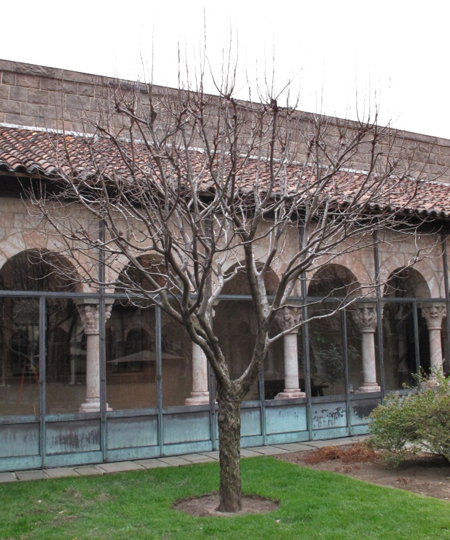
The pruning of our fruit trees is undertaken in winter, when the trees are dormant. Above: One of four pollarded crab apples in need of pruning in Cuxa garden
The first important horticultural task of the New Year was the pruning of the crab apples in Cuxa cloister garth garden. (This year, the work was performed on Plough Monday, the traditional day on which farmers and workers returned to the fields after the Christmas rest. For a nineteenth-century account of the history of Plough Monday in English tradition, see Chambers’s Journal of popular literature, science and arts, Vol. 56.) Read more »
Tags: crab apple, pollard
Posted in Gardening at The Cloisters | Comments (5)
Thursday, December 15, 2011
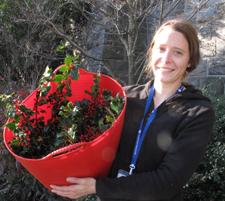
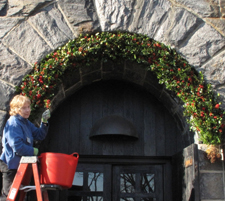
Above, from left to right: Gardener Esme Webb carrying a trug of English holly; volunteer Nuala Outes putting berried holly branches into the arch over the postern gate entrance.
Visitors entering the Museum by the postern gate (the main entrance to The Cloisters) from now through the first week of January will pass under a great arch of holly, the plant most strongly associated with the medieval celebration of Christmastide. (For more on the medieval significance of this beautiful and beloved tree, see “The Holly and The Ivy,” December 18, 2008). The ceremonial placing of a beneficent plant above a doorway is an ancient practice common to many cultures and periods. (Four of the doorways in the Main Hall are adorned with arches of ivy, apples, hazelnuts, and rose hips; see “Decking the Halls: The Arches,” December 2, 2008.) Read more »
Tags: apple, Christmastide, dioecious, hazelnut, holly, ivy, rose hip
Posted in Gardening at The Cloisters, The Medieval Calendar | Comments (4)
Friday, November 25, 2011
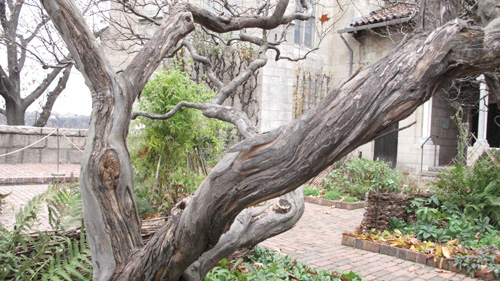
Now that this??veteran quince has regained vigor and the branches have grown thicker, the bark is splitting under the pressure of the increased diameter. The plates formed by the??exfoliating bark add to the beauty and ornamental value of the tree.
The beloved and beautiful quartet of quince (Cydonia oblonga) trees at the center of Bonnefont garden, an iconic image of The Cloisters worldwide, was showing??its age when I first came to The Cloisters as consulting arborist in 2007. The trees were nutritionally deprived, had suffered from both summer and winter drought, and were subject to several fungal diseases, as well as insect infestations, especially apple maggot. Read more »
Tags: apple maggot, bark, Cydonia oblonga, drought, fungal, insect, plating, quince
Posted in Food and Beverage Plants, Gardening at The Cloisters | Comments (11)
Friday, November 18, 2011
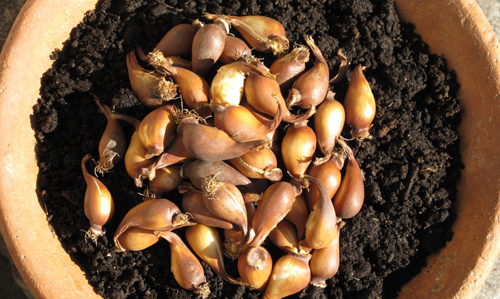
These small bulbs of Tulipa biflora, a species native to the Southern Balkans and Southeastern Russia, are to be planted today in Cuxa garden, the only one of our three gardens in which ??post-medieval plants are grown. The tulip did not reach Europe until the sixteenth century.?? Photograph by D. Larkin
Tulips, spring-blooming crocuses, winter aconites, fritillarias, and other bulbous plants native to Asia came too late to Europe to find a home in the medieval plant collections in Bonnefont and Trie gardens, but they do have an honored place in Cuxa cloister garden. Cuxa has been the main ornamental garden for the Museum since 1938, and has always included both modern and medieval plants in order to provide a continuous display from early spring until late fall. Read more »
Tags: Bulbs, Fritillaria, Holland, Linnaeus, tulip, Tulipa biflora, Tulipa humilis, Tulipa saxatilis, Tulipa turkestanica, winter aconite
Posted in Botany for Gardeners, Gardening at The Cloisters | Comments (0)
Friday, October 28, 2011
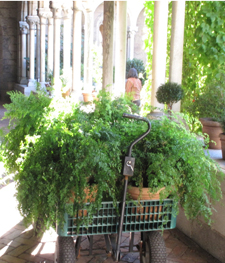
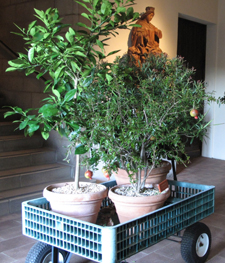
Potted plants too tender to spend the winter in Bonnefont garden are trucked inside and brought up to Cuxa cloister, which is??glazed in mid-October. Mediterranean plants such as bitter orange, myrtle, and bay laurel spend the cold season in the sunny arcades and??are brought back out to the herb garden when the glass comes down in mid-April. Left:??A wagonload of maidenhair fern in the arcade of Bonnefont garden. Right:??oranges and pomegranates en route to Cuxa cloister.?? Photographs by Carly Still
While the medieval plant collection at The Cloisters includes a good number of northern European species, a great many of the plants grown in the Bonnefont Cloister herb garden are Mediterranean in origin. Not all of these southern European plants are hardy for us here in New York City. The garden is a sheltered U.S.D.A. Hardiness Zone 7, and the fig tree (Ficus carica), poet’s jasmine (Jasminum officinale), and lavender (Lavandula angustifolia) do just fine outdoors, but more tender species like bitter orange (Citrus aurantium), rosemary (Rosmarinus officinalis), bay laurel (Laurus nobilis), and dittany of Crete (Origanum dictamnus) must be brought inside and protected from the cold. Read more »
Tags: Albertus Magnus, bay, Citrus aurantium, cucumber, cucurbit, dittany, fern, ficus carica, fig, jasmine, Jasminum officinale, laurel, Laurus nobilis, Lavandula angustifolia, Lavender, maidenhair, myrtle, orange, Origanum dictamnus, rosemary, Rosmarinus officinalis, santolina, winter
Posted in Food and Beverage Plants, Fragrant Plants, Gardening at The Cloisters, Introduction, Magical Plants, Medicinal Plants, Medieval Agriculture, Plants in Medieval Art | Comments (2)
Friday, October 21, 2011
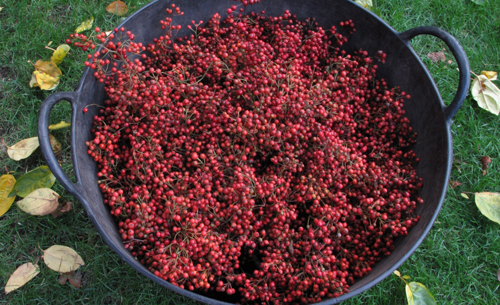
A tub of rose hips, gathered from roadsides and abandoned pastures upstate, and stripped of their thorns. The hips will be used to decorate the Museum this winter. Photograph by Carly Still
The rose hips used in the winter holiday decorations at The Cloisters allude to the rose symbolism prevalent in medieval Christmas carols. Although we grow medieval rose species in the gardens and on the grounds, their hips are too fleshy for our purposes, and don’t keep well.?? We gather stems of Rosa multiflora, which bear many small, hard, hips, in October, and strip them??of their thorns. They are stored in a cool, dry place until December, when the Museum is decked for the season.
Read more »
Tags: cattle, erosion, hips, Japanese rose, Rosa multiflora, rose, rose hip, weed
Posted in Food and Beverage Plants, Gardening at The Cloisters, Medicinal Plants, Useful Plants | Comments (1)
Thursday, September 8, 2011
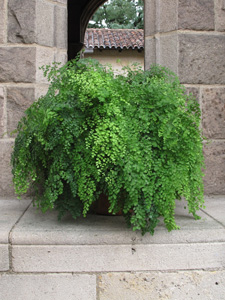
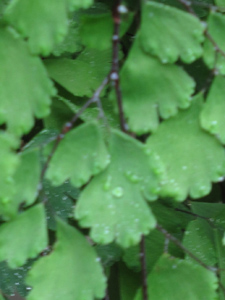
The lovely Venus maidenhair is not quite hardy for us at The Cloisters, and is grown in pots in the medieval gardens. The pinnules of this graceful fern, which flourishes in moist and rocky situations in many parts of the world, repel water.?? Photographs by Carly Still
The southern or Venus maidenhair (Adiantum capillis-veneris)??belongs to a large genus of ferns that includes two hundred species. The botanical name given to the genus Adiantum is from the Greek for “unwetted,” since any water falling on the foliage of these ferns beads up, leaving the leaf surfaces dry. This species was??already known by that name??in classical antiquity; the Roman natural historian Pliny marveled that a plant that grew in moist places exhibited such a marked antipathy to water. According to Pliny, the plant??was known to some as “beautiful hair” or “thick hair.”?? A decoction of the fern, made by??simmering it with celery seed in wine and oil, was used both to dye the hair and to prevent it??from falling out (Historia naturalis, Book XXII, 62???65). Read more »
Tags: Adiantum, baldness, Dioscorides, fern, Hortus Sanitatis, maidenhair, Maude Grieve, pinnule, Pliny, Rufinus, Salerno, stipe, Venus
Posted in Gardening at The Cloisters, Medicinal Plants | Comments (5)
Thursday, August 11, 2011
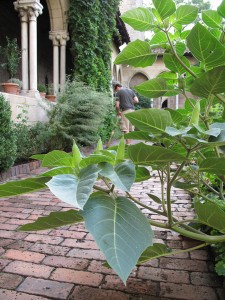
My early morning sweep of Bonnefont garden, overseen by the downy thornapple (Datura metel). Photograph by Corey Eilhardt
A quiet life has many rewards: not least of these
Is the joy that comes to him who devotes himself to the art
They knew at Paestum, and learns the ancient skill of obscene
Priapus???the joy that comes of devoting himself to a garden.
???From Hortulus by Walahfrid Strabo. Translated from the Latin by Raef Payne. The Hunt Botanical Library, 1966.
Read more »
Tags: Benedict, Benedictine, bryan_stevenson, ground ivy, internship, jasmine, monk, nightshade, nun, pear, potato beetle, spearmint, Walahfrid Strabo
Posted in Gardening at The Cloisters, Plants in Medieval Art | Comments (4)
Friday, August 5, 2011
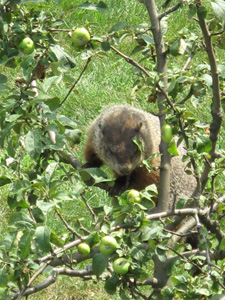
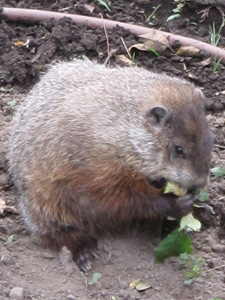
Woodchucks, also known as groundhogs, live in burrows but can and do climb trees. They’re particularly fond of apples. Photographs by Corey Eilhardt
How much wood could a woodchuck chuck,
If a woodchuck could chuck wood?
Woodchucks don’t chuck wood, except in tongue twisters and insurance commercials.
Woodchucks (Marmota monax), also known as groundhogs or whistle pigs, are rodents, as are more than half of the world’s mammalian species. They belong to the same family as the squirrel, although woodchucks live underground and squirrels nest in trees. The English name of this common North American mammal derives from the Alogonquian wuchak.
Read more »
Tags: apple, groundhog, Marmota monax, squirrel, woodchuck
Posted in Gardening at The Cloisters | Comments (9)
Thursday, July 21, 2011
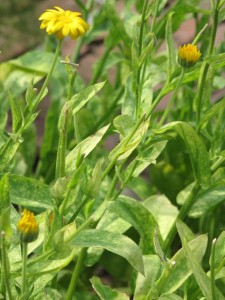
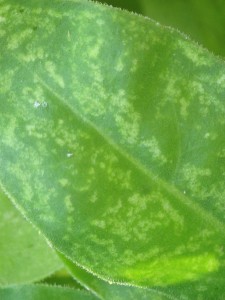
Left: A severe infestation of two-spotted mites on a calendula growing in Bonnefont garden. Right: A detail of the damage done by this common hot-weather garden pest, which sucks the chlorophyll from the leaves of the host plant. Photographs by Corey Eilhardt
The hot, dry weather that has us struggling to keep the gardens watered is all too welcome to the two-spotted mite, Tetranychus urticae, a worldwide pest of crop plants, ornamentals, and houseplants that is as much at home in greenhouses and apartments as it is outdoors. Two-spotted mites, along with other members of the Tetranychus family, are commonly known as spider mites. They are arachnids but are more closely related to ticks than to spiders.
Read more »
Tags: Bonnefont Garden, Calendula officinalis, catmint, hops, humulus lupulus, lady???s mantle, Levisticum officinale, lovage, meadow rue, Nepeta x faassenii, pest, Phytoseiulus persimilis, pot marigold, spider mites, Tetranychus urticae, Thalictrum aquilegifolium, two-spotted mite
Posted in Botany for Gardeners, Gardening at The Cloisters | Comments (2)















